Strategic Quality and System Management in Abu Dhabi Healthcare
VerifiedAdded on 2020/04/13
|25
|3877
|40
Report
AI Summary
This report investigates the crucial relationship between service quality, system management, customer care, and patient loyalty within the healthcare sector, specifically focusing on the context of Abu Dhabi, UAE. The study employs a mixed-methods approach, incorporating both quantitative and qualitative data collection techniques. Quantitative data was gathered through surveys administered to 30 patients at a healthcare center, utilizing close-ended questions to assess their satisfaction levels and perceptions of customer care. Qualitative data was collected via interviews with three physicians, employing open-ended questions to gain insights into their perspectives on service quality and patient behavior. The findings, presented through tables, graphs, and thematic analysis, reveal a significant positive correlation between customer care and patient satisfaction, as well as the importance of responsive customer service and supportive staff behavior. The report also discusses physicians' views on leveraging technology and multi-channel communication to enhance customer service and patient loyalty, ultimately contributing to the understanding of effective strategies for sustainable service delivery in the competitive healthcare landscape.
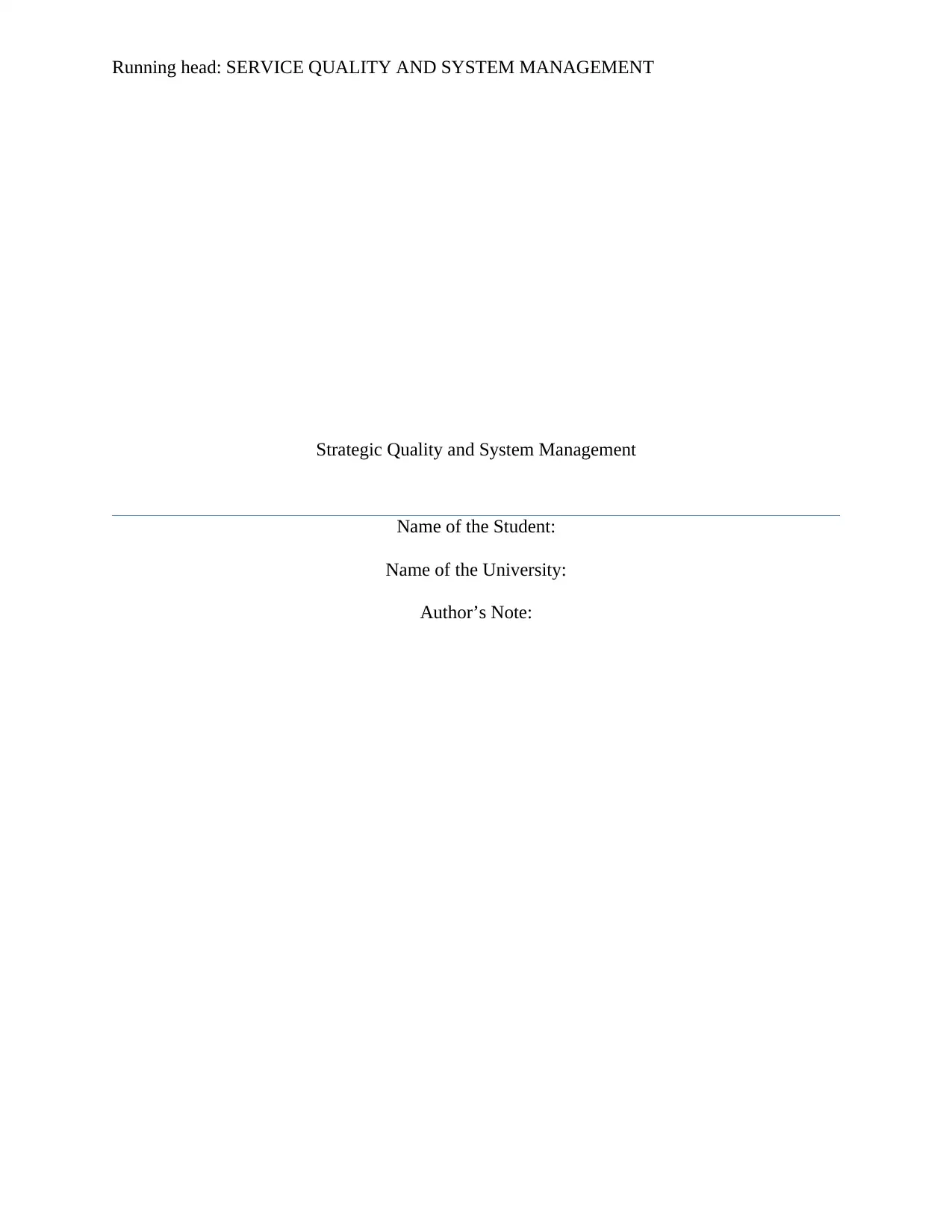
Running head: SERVICE QUALITY AND SYSTEM MANAGEMENT
Strategic Quality and System Management
Name of the Student:
Name of the University:
Author’s Note:
Strategic Quality and System Management
Name of the Student:
Name of the University:
Author’s Note:
Paraphrase This Document
Need a fresh take? Get an instant paraphrase of this document with our AI Paraphraser
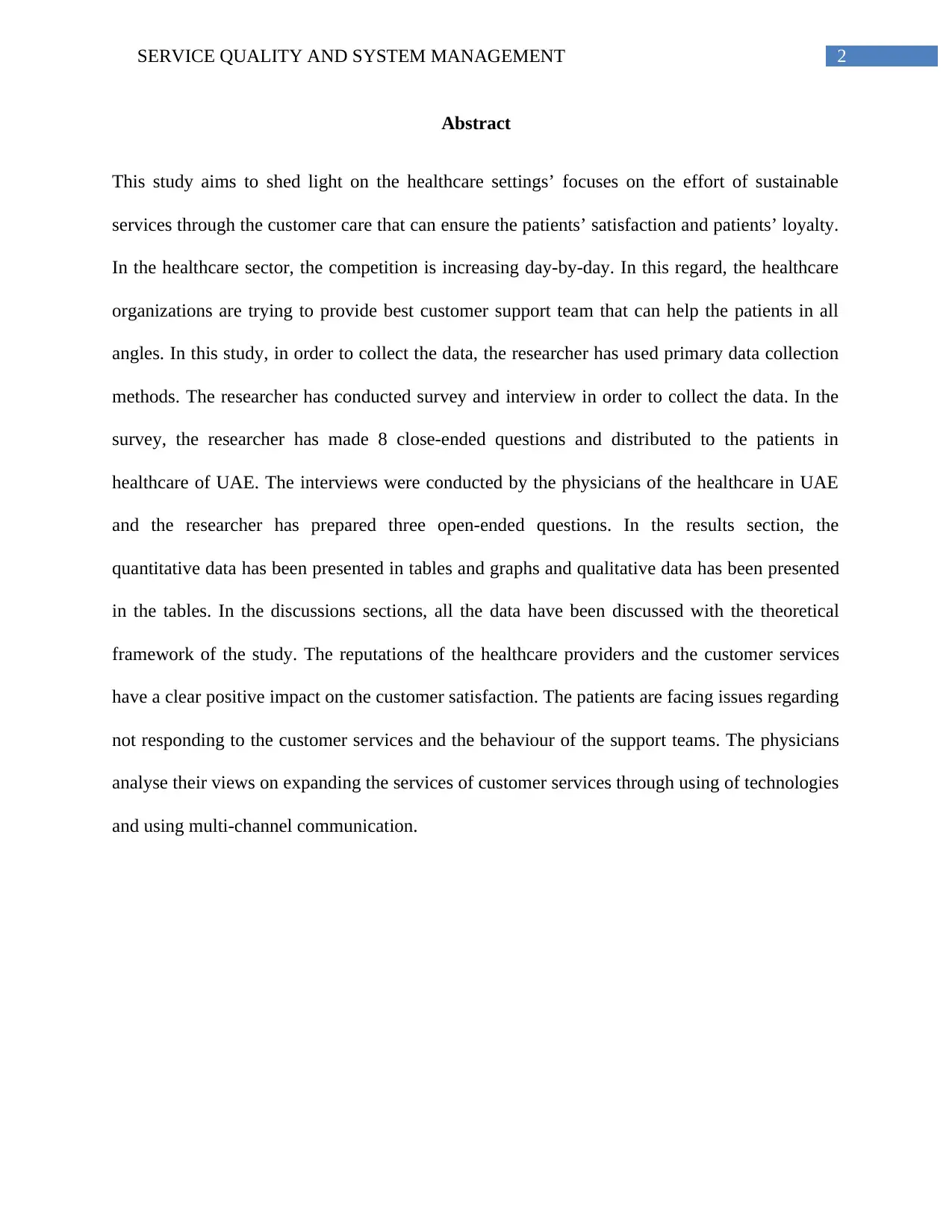
2SERVICE QUALITY AND SYSTEM MANAGEMENT
Abstract
This study aims to shed light on the healthcare settings’ focuses on the effort of sustainable
services through the customer care that can ensure the patients’ satisfaction and patients’ loyalty.
In the healthcare sector, the competition is increasing day-by-day. In this regard, the healthcare
organizations are trying to provide best customer support team that can help the patients in all
angles. In this study, in order to collect the data, the researcher has used primary data collection
methods. The researcher has conducted survey and interview in order to collect the data. In the
survey, the researcher has made 8 close-ended questions and distributed to the patients in
healthcare of UAE. The interviews were conducted by the physicians of the healthcare in UAE
and the researcher has prepared three open-ended questions. In the results section, the
quantitative data has been presented in tables and graphs and qualitative data has been presented
in the tables. In the discussions sections, all the data have been discussed with the theoretical
framework of the study. The reputations of the healthcare providers and the customer services
have a clear positive impact on the customer satisfaction. The patients are facing issues regarding
not responding to the customer services and the behaviour of the support teams. The physicians
analyse their views on expanding the services of customer services through using of technologies
and using multi-channel communication.
Abstract
This study aims to shed light on the healthcare settings’ focuses on the effort of sustainable
services through the customer care that can ensure the patients’ satisfaction and patients’ loyalty.
In the healthcare sector, the competition is increasing day-by-day. In this regard, the healthcare
organizations are trying to provide best customer support team that can help the patients in all
angles. In this study, in order to collect the data, the researcher has used primary data collection
methods. The researcher has conducted survey and interview in order to collect the data. In the
survey, the researcher has made 8 close-ended questions and distributed to the patients in
healthcare of UAE. The interviews were conducted by the physicians of the healthcare in UAE
and the researcher has prepared three open-ended questions. In the results section, the
quantitative data has been presented in tables and graphs and qualitative data has been presented
in the tables. In the discussions sections, all the data have been discussed with the theoretical
framework of the study. The reputations of the healthcare providers and the customer services
have a clear positive impact on the customer satisfaction. The patients are facing issues regarding
not responding to the customer services and the behaviour of the support teams. The physicians
analyse their views on expanding the services of customer services through using of technologies
and using multi-channel communication.
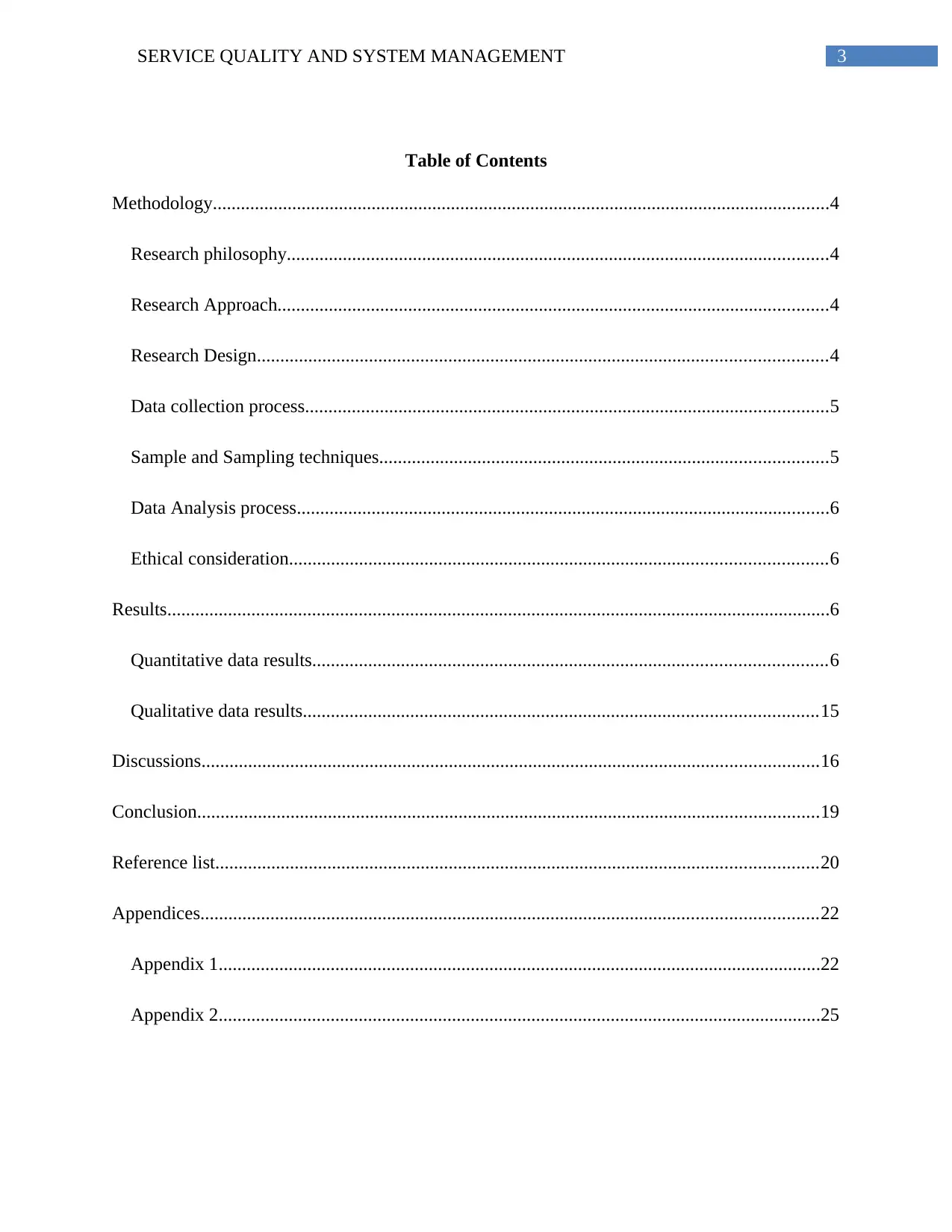
3SERVICE QUALITY AND SYSTEM MANAGEMENT
Table of Contents
Methodology....................................................................................................................................4
Research philosophy....................................................................................................................4
Research Approach......................................................................................................................4
Research Design..........................................................................................................................4
Data collection process................................................................................................................5
Sample and Sampling techniques................................................................................................5
Data Analysis process..................................................................................................................6
Ethical consideration...................................................................................................................6
Results..............................................................................................................................................6
Quantitative data results..............................................................................................................6
Qualitative data results..............................................................................................................15
Discussions....................................................................................................................................16
Conclusion.....................................................................................................................................19
Reference list.................................................................................................................................20
Appendices....................................................................................................................................22
Appendix 1.................................................................................................................................22
Appendix 2.................................................................................................................................25
Table of Contents
Methodology....................................................................................................................................4
Research philosophy....................................................................................................................4
Research Approach......................................................................................................................4
Research Design..........................................................................................................................4
Data collection process................................................................................................................5
Sample and Sampling techniques................................................................................................5
Data Analysis process..................................................................................................................6
Ethical consideration...................................................................................................................6
Results..............................................................................................................................................6
Quantitative data results..............................................................................................................6
Qualitative data results..............................................................................................................15
Discussions....................................................................................................................................16
Conclusion.....................................................................................................................................19
Reference list.................................................................................................................................20
Appendices....................................................................................................................................22
Appendix 1.................................................................................................................................22
Appendix 2.................................................................................................................................25
⊘ This is a preview!⊘
Do you want full access?
Subscribe today to unlock all pages.

Trusted by 1+ million students worldwide

4SERVICE QUALITY AND SYSTEM MANAGEMENT
Paraphrase This Document
Need a fresh take? Get an instant paraphrase of this document with our AI Paraphraser
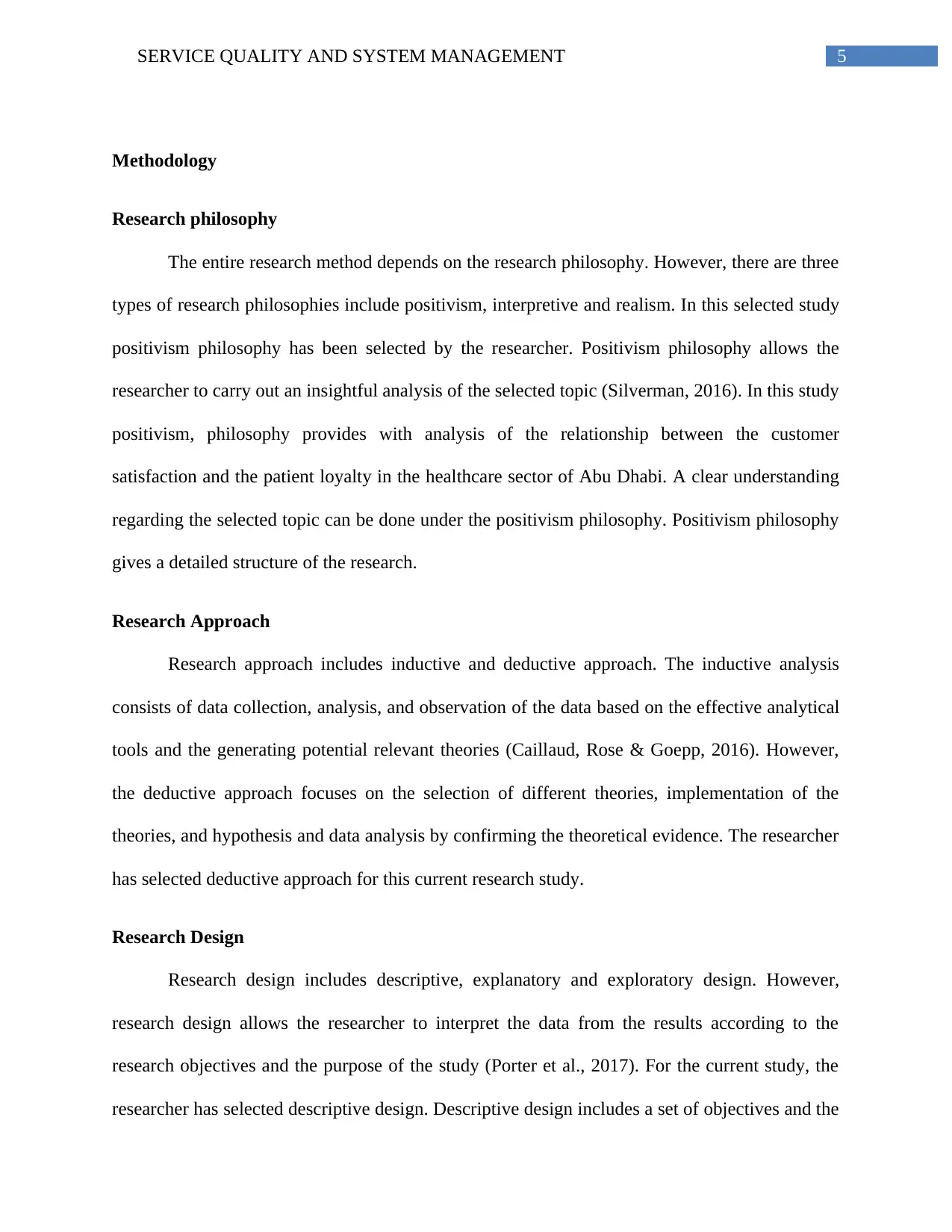
5SERVICE QUALITY AND SYSTEM MANAGEMENT
Methodology
Research philosophy
The entire research method depends on the research philosophy. However, there are three
types of research philosophies include positivism, interpretive and realism. In this selected study
positivism philosophy has been selected by the researcher. Positivism philosophy allows the
researcher to carry out an insightful analysis of the selected topic (Silverman, 2016). In this study
positivism, philosophy provides with analysis of the relationship between the customer
satisfaction and the patient loyalty in the healthcare sector of Abu Dhabi. A clear understanding
regarding the selected topic can be done under the positivism philosophy. Positivism philosophy
gives a detailed structure of the research.
Research Approach
Research approach includes inductive and deductive approach. The inductive analysis
consists of data collection, analysis, and observation of the data based on the effective analytical
tools and the generating potential relevant theories (Caillaud, Rose & Goepp, 2016). However,
the deductive approach focuses on the selection of different theories, implementation of the
theories, and hypothesis and data analysis by confirming the theoretical evidence. The researcher
has selected deductive approach for this current research study.
Research Design
Research design includes descriptive, explanatory and exploratory design. However,
research design allows the researcher to interpret the data from the results according to the
research objectives and the purpose of the study (Porter et al., 2017). For the current study, the
researcher has selected descriptive design. Descriptive design includes a set of objectives and the
Methodology
Research philosophy
The entire research method depends on the research philosophy. However, there are three
types of research philosophies include positivism, interpretive and realism. In this selected study
positivism philosophy has been selected by the researcher. Positivism philosophy allows the
researcher to carry out an insightful analysis of the selected topic (Silverman, 2016). In this study
positivism, philosophy provides with analysis of the relationship between the customer
satisfaction and the patient loyalty in the healthcare sector of Abu Dhabi. A clear understanding
regarding the selected topic can be done under the positivism philosophy. Positivism philosophy
gives a detailed structure of the research.
Research Approach
Research approach includes inductive and deductive approach. The inductive analysis
consists of data collection, analysis, and observation of the data based on the effective analytical
tools and the generating potential relevant theories (Caillaud, Rose & Goepp, 2016). However,
the deductive approach focuses on the selection of different theories, implementation of the
theories, and hypothesis and data analysis by confirming the theoretical evidence. The researcher
has selected deductive approach for this current research study.
Research Design
Research design includes descriptive, explanatory and exploratory design. However,
research design allows the researcher to interpret the data from the results according to the
research objectives and the purpose of the study (Porter et al., 2017). For the current study, the
researcher has selected descriptive design. Descriptive design includes a set of objectives and the
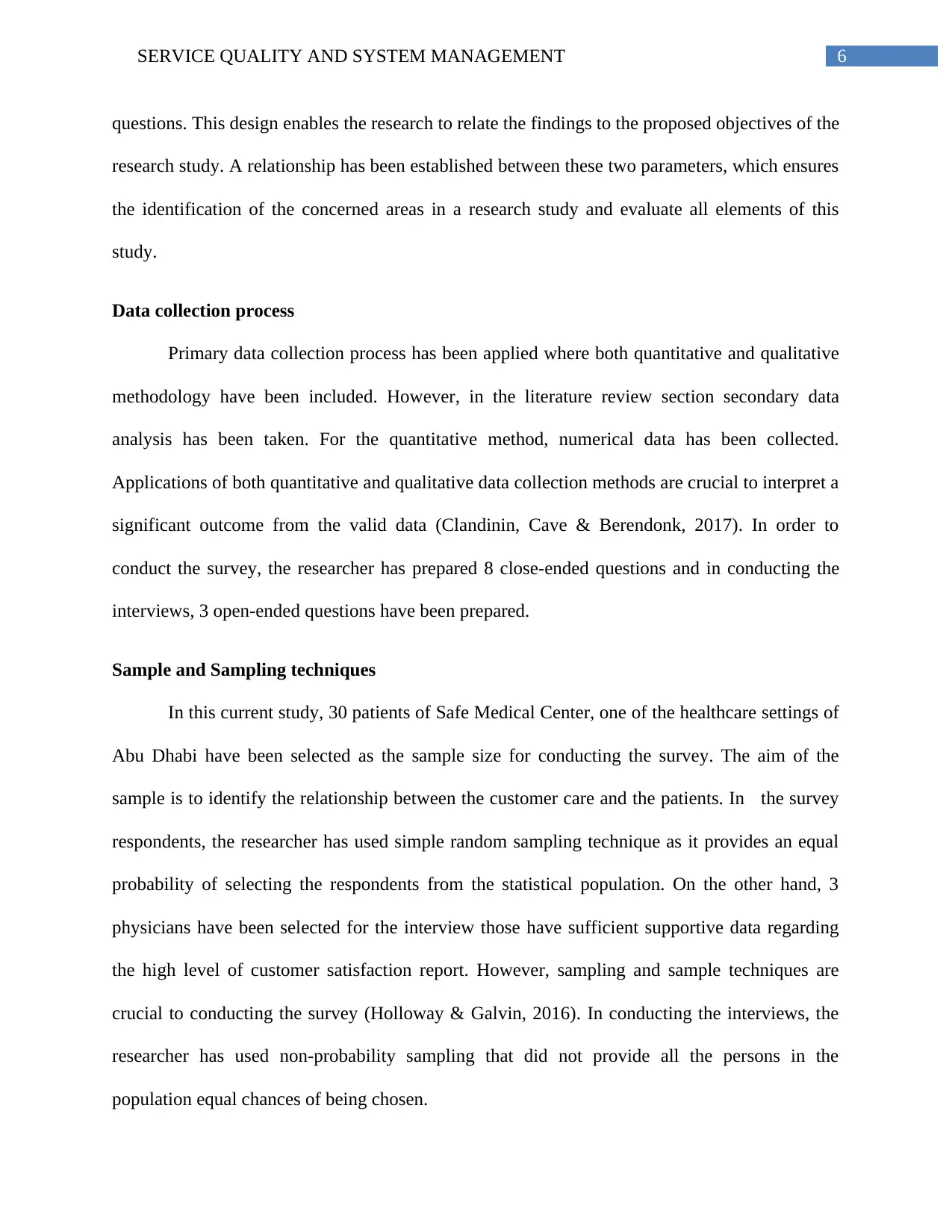
6SERVICE QUALITY AND SYSTEM MANAGEMENT
questions. This design enables the research to relate the findings to the proposed objectives of the
research study. A relationship has been established between these two parameters, which ensures
the identification of the concerned areas in a research study and evaluate all elements of this
study.
Data collection process
Primary data collection process has been applied where both quantitative and qualitative
methodology have been included. However, in the literature review section secondary data
analysis has been taken. For the quantitative method, numerical data has been collected.
Applications of both quantitative and qualitative data collection methods are crucial to interpret a
significant outcome from the valid data (Clandinin, Cave & Berendonk, 2017). In order to
conduct the survey, the researcher has prepared 8 close-ended questions and in conducting the
interviews, 3 open-ended questions have been prepared.
Sample and Sampling techniques
In this current study, 30 patients of Safe Medical Center, one of the healthcare settings of
Abu Dhabi have been selected as the sample size for conducting the survey. The aim of the
sample is to identify the relationship between the customer care and the patients. In the survey
respondents, the researcher has used simple random sampling technique as it provides an equal
probability of selecting the respondents from the statistical population. On the other hand, 3
physicians have been selected for the interview those have sufficient supportive data regarding
the high level of customer satisfaction report. However, sampling and sample techniques are
crucial to conducting the survey (Holloway & Galvin, 2016). In conducting the interviews, the
researcher has used non-probability sampling that did not provide all the persons in the
population equal chances of being chosen.
questions. This design enables the research to relate the findings to the proposed objectives of the
research study. A relationship has been established between these two parameters, which ensures
the identification of the concerned areas in a research study and evaluate all elements of this
study.
Data collection process
Primary data collection process has been applied where both quantitative and qualitative
methodology have been included. However, in the literature review section secondary data
analysis has been taken. For the quantitative method, numerical data has been collected.
Applications of both quantitative and qualitative data collection methods are crucial to interpret a
significant outcome from the valid data (Clandinin, Cave & Berendonk, 2017). In order to
conduct the survey, the researcher has prepared 8 close-ended questions and in conducting the
interviews, 3 open-ended questions have been prepared.
Sample and Sampling techniques
In this current study, 30 patients of Safe Medical Center, one of the healthcare settings of
Abu Dhabi have been selected as the sample size for conducting the survey. The aim of the
sample is to identify the relationship between the customer care and the patients. In the survey
respondents, the researcher has used simple random sampling technique as it provides an equal
probability of selecting the respondents from the statistical population. On the other hand, 3
physicians have been selected for the interview those have sufficient supportive data regarding
the high level of customer satisfaction report. However, sampling and sample techniques are
crucial to conducting the survey (Holloway & Galvin, 2016). In conducting the interviews, the
researcher has used non-probability sampling that did not provide all the persons in the
population equal chances of being chosen.
⊘ This is a preview!⊘
Do you want full access?
Subscribe today to unlock all pages.

Trusted by 1+ million students worldwide
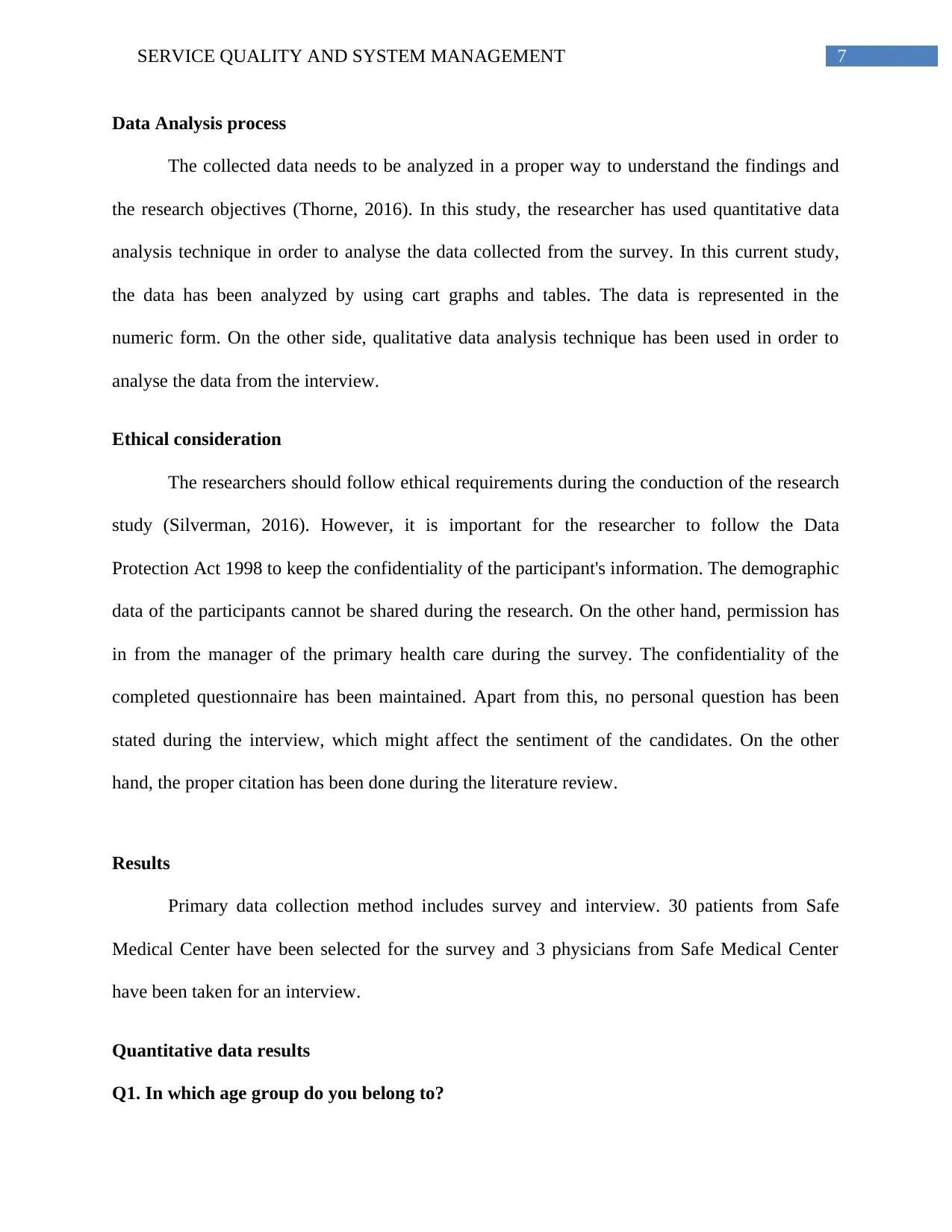
7SERVICE QUALITY AND SYSTEM MANAGEMENT
Data Analysis process
The collected data needs to be analyzed in a proper way to understand the findings and
the research objectives (Thorne, 2016). In this study, the researcher has used quantitative data
analysis technique in order to analyse the data collected from the survey. In this current study,
the data has been analyzed by using cart graphs and tables. The data is represented in the
numeric form. On the other side, qualitative data analysis technique has been used in order to
analyse the data from the interview.
Ethical consideration
The researchers should follow ethical requirements during the conduction of the research
study (Silverman, 2016). However, it is important for the researcher to follow the Data
Protection Act 1998 to keep the confidentiality of the participant's information. The demographic
data of the participants cannot be shared during the research. On the other hand, permission has
in from the manager of the primary health care during the survey. The confidentiality of the
completed questionnaire has been maintained. Apart from this, no personal question has been
stated during the interview, which might affect the sentiment of the candidates. On the other
hand, the proper citation has been done during the literature review.
Results
Primary data collection method includes survey and interview. 30 patients from Safe
Medical Center have been selected for the survey and 3 physicians from Safe Medical Center
have been taken for an interview.
Quantitative data results
Q1. In which age group do you belong to?
Data Analysis process
The collected data needs to be analyzed in a proper way to understand the findings and
the research objectives (Thorne, 2016). In this study, the researcher has used quantitative data
analysis technique in order to analyse the data collected from the survey. In this current study,
the data has been analyzed by using cart graphs and tables. The data is represented in the
numeric form. On the other side, qualitative data analysis technique has been used in order to
analyse the data from the interview.
Ethical consideration
The researchers should follow ethical requirements during the conduction of the research
study (Silverman, 2016). However, it is important for the researcher to follow the Data
Protection Act 1998 to keep the confidentiality of the participant's information. The demographic
data of the participants cannot be shared during the research. On the other hand, permission has
in from the manager of the primary health care during the survey. The confidentiality of the
completed questionnaire has been maintained. Apart from this, no personal question has been
stated during the interview, which might affect the sentiment of the candidates. On the other
hand, the proper citation has been done during the literature review.
Results
Primary data collection method includes survey and interview. 30 patients from Safe
Medical Center have been selected for the survey and 3 physicians from Safe Medical Center
have been taken for an interview.
Quantitative data results
Q1. In which age group do you belong to?
Paraphrase This Document
Need a fresh take? Get an instant paraphrase of this document with our AI Paraphraser
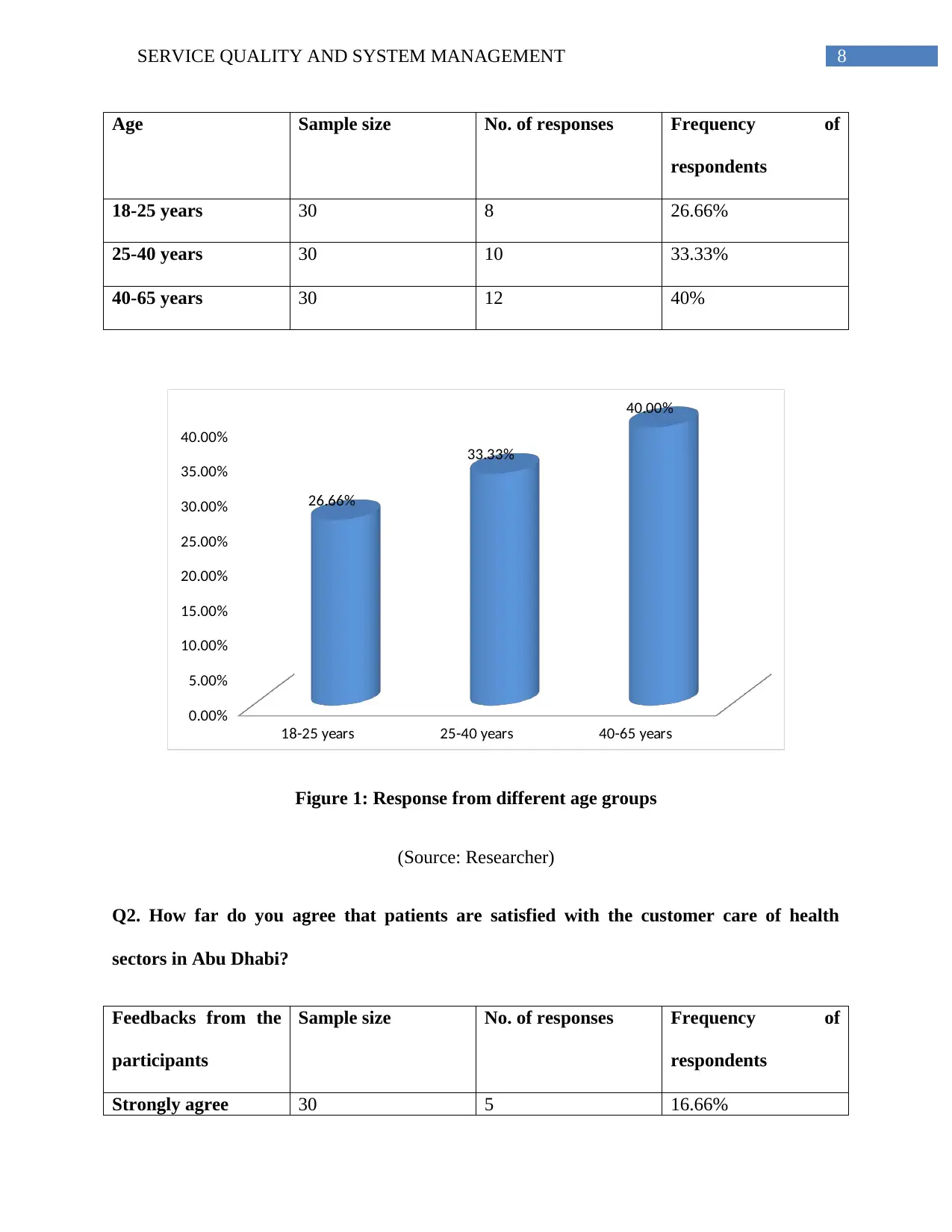
8SERVICE QUALITY AND SYSTEM MANAGEMENT
Age Sample size No. of responses Frequency of
respondents
18-25 years 30 8 26.66%
25-40 years 30 10 33.33%
40-65 years 30 12 40%
18-25 years 25-40 years 40-65 years
0.00%
5.00%
10.00%
15.00%
20.00%
25.00%
30.00%
35.00%
40.00%
26.66%
33.33%
40.00%
Figure 1: Response from different age groups
(Source: Researcher)
Q2. How far do you agree that patients are satisfied with the customer care of health
sectors in Abu Dhabi?
Feedbacks from the
participants
Sample size No. of responses Frequency of
respondents
Strongly agree 30 5 16.66%
Age Sample size No. of responses Frequency of
respondents
18-25 years 30 8 26.66%
25-40 years 30 10 33.33%
40-65 years 30 12 40%
18-25 years 25-40 years 40-65 years
0.00%
5.00%
10.00%
15.00%
20.00%
25.00%
30.00%
35.00%
40.00%
26.66%
33.33%
40.00%
Figure 1: Response from different age groups
(Source: Researcher)
Q2. How far do you agree that patients are satisfied with the customer care of health
sectors in Abu Dhabi?
Feedbacks from the
participants
Sample size No. of responses Frequency of
respondents
Strongly agree 30 5 16.66%
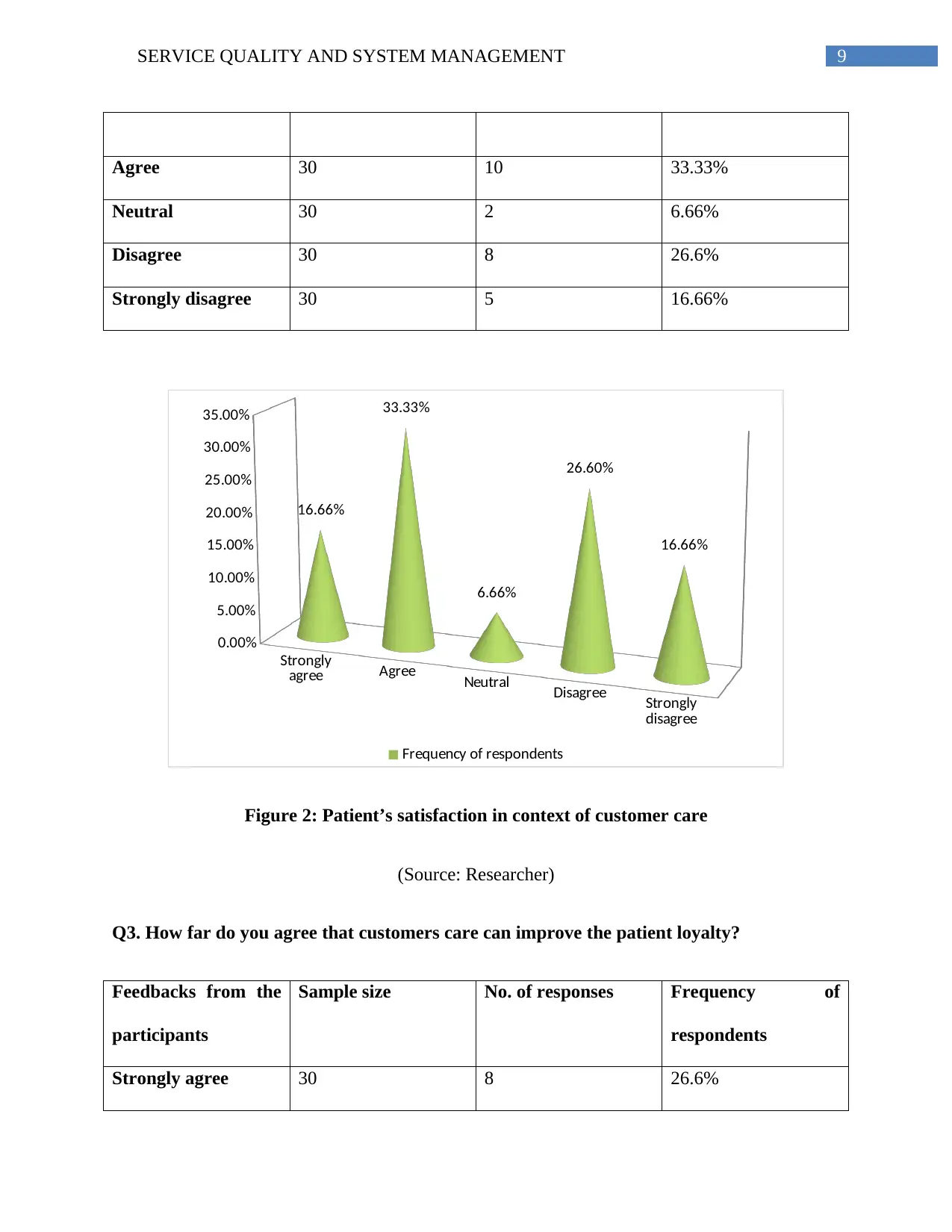
9SERVICE QUALITY AND SYSTEM MANAGEMENT
Agree 30 10 33.33%
Neutral 30 2 6.66%
Disagree 30 8 26.6%
Strongly disagree 30 5 16.66%
Strongly
agree Agree Neutral Disagree Strongly
disagree
0.00%
5.00%
10.00%
15.00%
20.00%
25.00%
30.00%
35.00%
16.66%
33.33%
6.66%
26.60%
16.66%
Frequency of respondents
Figure 2: Patient’s satisfaction in context of customer care
(Source: Researcher)
Q3. How far do you agree that customers care can improve the patient loyalty?
Feedbacks from the
participants
Sample size No. of responses Frequency of
respondents
Strongly agree 30 8 26.6%
Agree 30 10 33.33%
Neutral 30 2 6.66%
Disagree 30 8 26.6%
Strongly disagree 30 5 16.66%
Strongly
agree Agree Neutral Disagree Strongly
disagree
0.00%
5.00%
10.00%
15.00%
20.00%
25.00%
30.00%
35.00%
16.66%
33.33%
6.66%
26.60%
16.66%
Frequency of respondents
Figure 2: Patient’s satisfaction in context of customer care
(Source: Researcher)
Q3. How far do you agree that customers care can improve the patient loyalty?
Feedbacks from the
participants
Sample size No. of responses Frequency of
respondents
Strongly agree 30 8 26.6%
⊘ This is a preview!⊘
Do you want full access?
Subscribe today to unlock all pages.

Trusted by 1+ million students worldwide
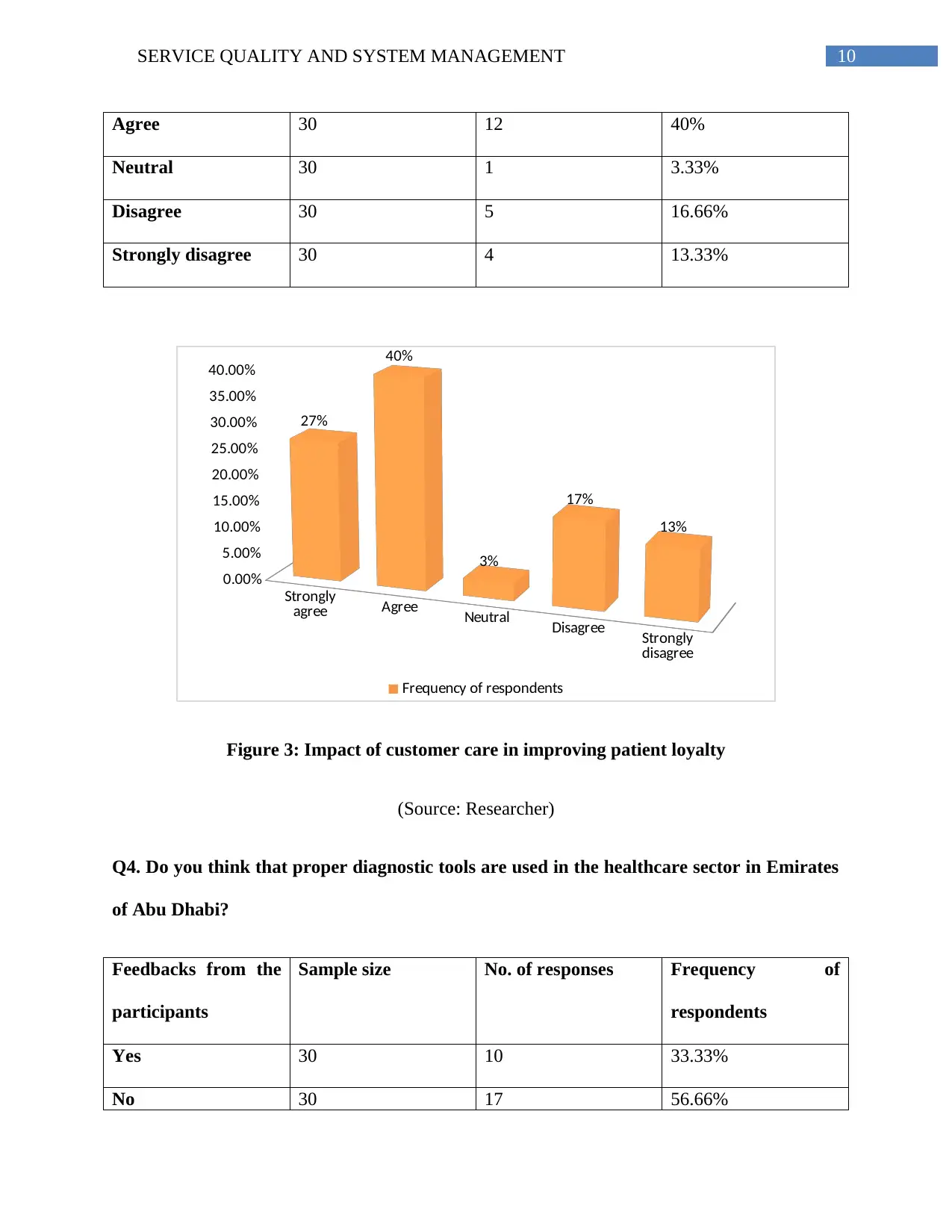
10SERVICE QUALITY AND SYSTEM MANAGEMENT
Agree 30 12 40%
Neutral 30 1 3.33%
Disagree 30 5 16.66%
Strongly disagree 30 4 13.33%
Strongly
agree Agree Neutral Disagree Strongly
disagree
0.00%
5.00%
10.00%
15.00%
20.00%
25.00%
30.00%
35.00%
40.00%
27%
40%
3%
17%
13%
Frequency of respondents
Figure 3: Impact of customer care in improving patient loyalty
(Source: Researcher)
Q4. Do you think that proper diagnostic tools are used in the healthcare sector in Emirates
of Abu Dhabi?
Feedbacks from the
participants
Sample size No. of responses Frequency of
respondents
Yes 30 10 33.33%
No 30 17 56.66%
Agree 30 12 40%
Neutral 30 1 3.33%
Disagree 30 5 16.66%
Strongly disagree 30 4 13.33%
Strongly
agree Agree Neutral Disagree Strongly
disagree
0.00%
5.00%
10.00%
15.00%
20.00%
25.00%
30.00%
35.00%
40.00%
27%
40%
3%
17%
13%
Frequency of respondents
Figure 3: Impact of customer care in improving patient loyalty
(Source: Researcher)
Q4. Do you think that proper diagnostic tools are used in the healthcare sector in Emirates
of Abu Dhabi?
Feedbacks from the
participants
Sample size No. of responses Frequency of
respondents
Yes 30 10 33.33%
No 30 17 56.66%
Paraphrase This Document
Need a fresh take? Get an instant paraphrase of this document with our AI Paraphraser
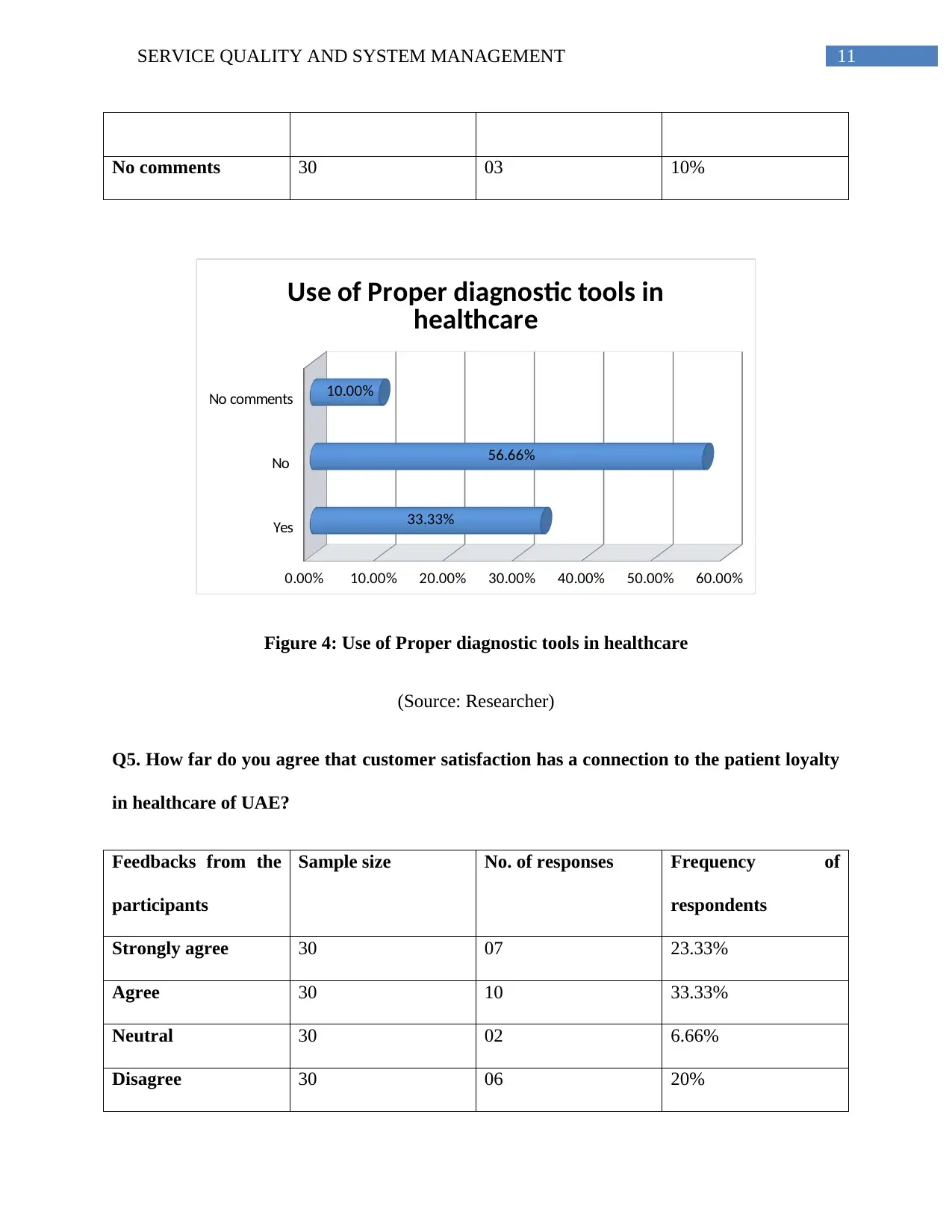
11SERVICE QUALITY AND SYSTEM MANAGEMENT
No comments 30 03 10%
Yes
No
No comments
0.00% 10.00% 20.00% 30.00% 40.00% 50.00% 60.00%
33.33%
56.66%
10.00%
Use of Proper diagnostic tools in
healthcare
Figure 4: Use of Proper diagnostic tools in healthcare
(Source: Researcher)
Q5. How far do you agree that customer satisfaction has a connection to the patient loyalty
in healthcare of UAE?
Feedbacks from the
participants
Sample size No. of responses Frequency of
respondents
Strongly agree 30 07 23.33%
Agree 30 10 33.33%
Neutral 30 02 6.66%
Disagree 30 06 20%
No comments 30 03 10%
Yes
No
No comments
0.00% 10.00% 20.00% 30.00% 40.00% 50.00% 60.00%
33.33%
56.66%
10.00%
Use of Proper diagnostic tools in
healthcare
Figure 4: Use of Proper diagnostic tools in healthcare
(Source: Researcher)
Q5. How far do you agree that customer satisfaction has a connection to the patient loyalty
in healthcare of UAE?
Feedbacks from the
participants
Sample size No. of responses Frequency of
respondents
Strongly agree 30 07 23.33%
Agree 30 10 33.33%
Neutral 30 02 6.66%
Disagree 30 06 20%
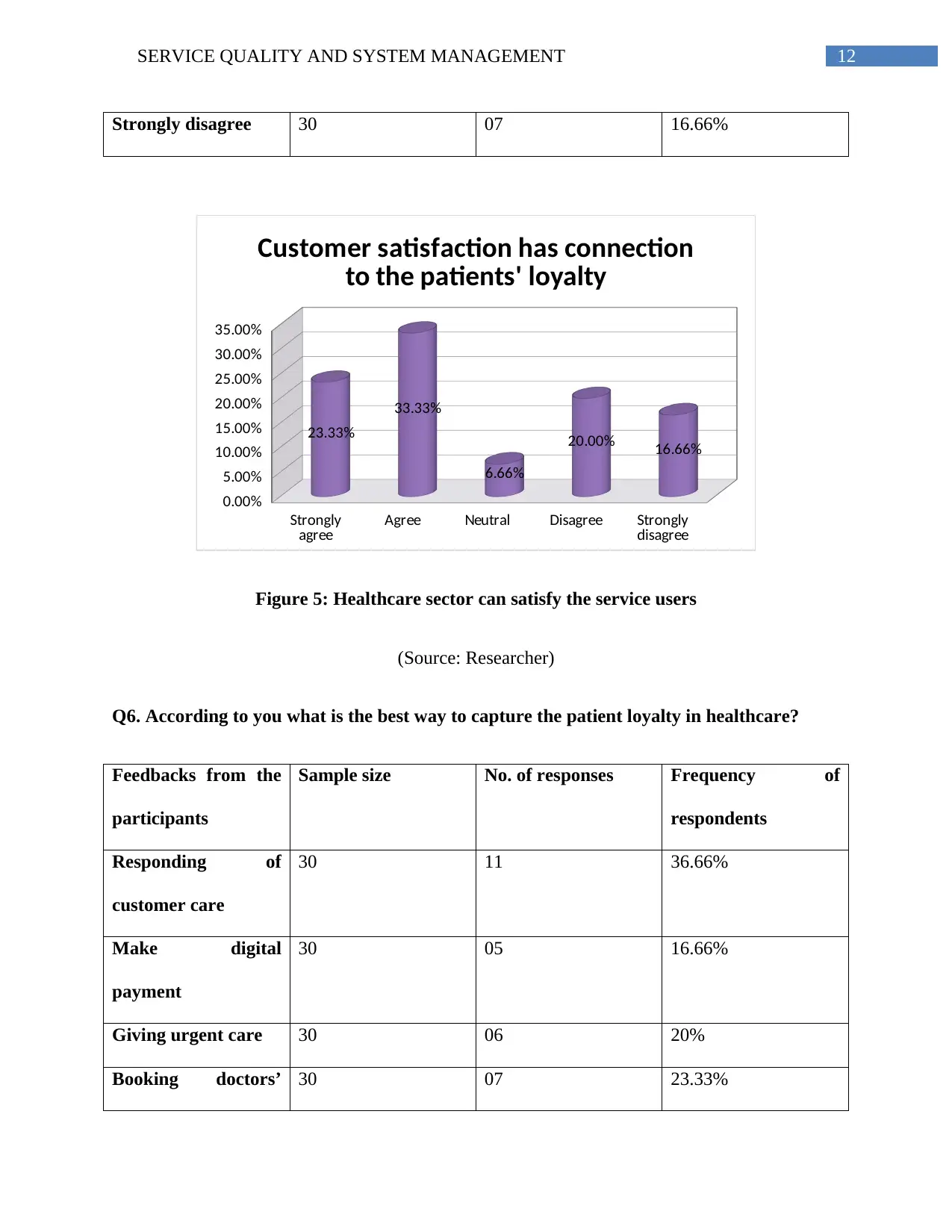
12SERVICE QUALITY AND SYSTEM MANAGEMENT
Strongly disagree 30 07 16.66%
Strongly
agree Agree Neutral Disagree Strongly
disagree
0.00%
5.00%
10.00%
15.00%
20.00%
25.00%
30.00%
35.00%
23.33%
33.33%
6.66%
20.00% 16.66%
Customer satisfaction has connection
to the patients' loyalty
Figure 5: Healthcare sector can satisfy the service users
(Source: Researcher)
Q6. According to you what is the best way to capture the patient loyalty in healthcare?
Feedbacks from the
participants
Sample size No. of responses Frequency of
respondents
Responding of
customer care
30 11 36.66%
Make digital
payment
30 05 16.66%
Giving urgent care 30 06 20%
Booking doctors’ 30 07 23.33%
Strongly disagree 30 07 16.66%
Strongly
agree Agree Neutral Disagree Strongly
disagree
0.00%
5.00%
10.00%
15.00%
20.00%
25.00%
30.00%
35.00%
23.33%
33.33%
6.66%
20.00% 16.66%
Customer satisfaction has connection
to the patients' loyalty
Figure 5: Healthcare sector can satisfy the service users
(Source: Researcher)
Q6. According to you what is the best way to capture the patient loyalty in healthcare?
Feedbacks from the
participants
Sample size No. of responses Frequency of
respondents
Responding of
customer care
30 11 36.66%
Make digital
payment
30 05 16.66%
Giving urgent care 30 06 20%
Booking doctors’ 30 07 23.33%
⊘ This is a preview!⊘
Do you want full access?
Subscribe today to unlock all pages.

Trusted by 1+ million students worldwide
1 out of 25
Related Documents
Your All-in-One AI-Powered Toolkit for Academic Success.
+13062052269
info@desklib.com
Available 24*7 on WhatsApp / Email
![[object Object]](/_next/static/media/star-bottom.7253800d.svg)
Unlock your academic potential
Copyright © 2020–2025 A2Z Services. All Rights Reserved. Developed and managed by ZUCOL.





